Game-Changing Pass Feasibility Prediction in Soccer Using Player Body-Orientation
A computational model to estimate the most feasible pass in soccer by leveraging offensive player’s orientation and opponents’ spatial configuration.
Introduction
The paper introduces a computational model aimed at enhancing football team performance by incorporating orientation metrics into the analysis of pass events. Pep Guardiola’s observation that modern football requires players to first look and orient themselves before controlling and passing the ball serves as the basis for this research. To avoid overcomplexity, the focus is narrowed to pass events, which are crucial moments where orientation plays a significant role.
The proposed model combines three different feasibility measures to assess the likelihood of a successful pass to potential receivers. Orientation is obtained using a state-of-the-art Computer Vision method that provides orientation values for each player based on their upper-torso pose parts in a 2D field. The novel feasibility measure assesses the orientation fit between the passer and potential receiver. Another metric takes into account the distance of all defenders relative to the passing line, determining how difficult it is for the passer to reach a specific player. Additionally, pairwise distances among offensive players are used to assess the separation between players, considering that closer players have a higher chance of receiving the ball.
The results demonstrate that the combination of all feasibility measures outperforms individual ones, and the model significantly benefits from the inclusion of orientation feasibility. Moreover, the model’s performance is shown to improve when orientation data is added to existing state-of-the-art models for pass outcome prediction.
The paper proceeds with a review of related research and the description of the proposed computational model in detail, including technical aspects. Feasibility results, discussions, and potential combinations are examined in the subsequent section, leading to promising conclusions about the potential of incorporating orientation metrics to refine football analytics and boost team performance.
Related work
The related work section of the research paper discusses prior research efforts in sports analytics, particularly focusing on football. The paper begins by acknowledging the significant impact of data science in sports performance enhancement, especially with the inclusion of tracking data for designing team strategies. The application of computer vision in sports analysis, particularly in football, has been a prominent topic, aiming to provide valuable insights for coaches to optimize tactics. Some recent contributions in football analytics have emphasized the utilization of tracking data to better understand the sport.
However, the authors highlight a limitation in the existing research, which is the lack of contextualization due to undefined variables, such as player body orientation. They refer to a method proposed by Arbues-Sangüesa et al., which aims to extract player body orientation from football video footage. This method uses OpenPose to detect player body keypoints and then estimates player orientation by combining the angle of the player with respect to the ball and a 2D projection of the normal vector to the upper-torso. The method achieves a median absolute error of 26 degrees/player and introduces three visualization tools for player orientation.
The paper also discusses the challenge of assigning value to individual player actions in football. Various passing probability models and quantification methods have been proposed, but none of them take player orientation into account. Fernandez et al. introduced a novel metric called Expected Possession Value (EPV) to predict the expected value of scoring/receiving a goal at a given time in any field position based on a spatial analysis of the offensive and defensive setup. However, the authors argue that these previous proposals could be improved by incorporating player orientation information into pass event analysis.
If you want to learn more about EPV check this article:
Proposed Pass-Orientation Model
The proposed Pass-Orientation Model aims to estimate the most likely recipient of a pass in football based on prior information that a player is about to execute a pass. The model introduces a feasibility score that takes into account player orientation and the configuration of both offensive and defensive teams in the 2D field at a given time.
The method operates on color video frames (u(·, t)) with discrete times {1, …, T}. Visible players in the frame at time t, along with their body orientation, are considered. The players’ orientations in the 2D field are obtained using the method described in a previous section. The notation for player positions and orientations on the 2D field is simplified for convenience, and the dependence on time is omitted.
Let P represent the player with the ball at time t, who is the passer, and let {Ri, i = 1, …, I} and {Dk, k = 1, …, K} represent the positions of visible team-mates and defenders, respectively. The former set comprises the potential recipients of the ball at time t + ∆t, where ∆t is the duration of the pass.
To determine the feasibility of a pass from player P to receiver Ri, three elements are considered: (a) the body orientation of every player, (b) the pressure from defenders Dk on both P and Ri, and (c) the relative position of Ri with respect to P. The feasibility measure F(i) for the pass event Hi (passing the ball to receiver Ri) is computed as a combination of three individual scores: orientation score Fo(i), defenders score Fd(i), and proximity score Fp(i).
The orientation score Fo(i) captures how well oriented the passer P and receiver Ri are to each other, while the defenders score Fd(i) evaluates the pressure exerted by the defenders on P and Ri. The proximity score Fp(i) reflects the relative distance between P and Ri.
The most feasible ball pass Hˆ is selected computationally by maximizing the feasibility measure F(i) over all potential receivers. The model makes this determination at the moment when the passer P kicks the ball.
By combining player orientation data and considering offensive and defensive team configurations, the proposed Pass-Orientation Model seeks to enhance pass event analysis, thus providing valuable insights into team performance and aiding coaches in designing optimal tactics.
Orientation
The research paper focuses also on the role of player body orientation in pass events and proposes a computational model to assess the feasibility of passes based on player orientations.
To determine the orientation of each player during a pass event, a window of ±Q frames around the pass moment is used, and the median value of the orientation within this window is considered as the player’s orientation at the pass moment. An orientation-based pass feasibility measure is introduced, which accounts for the geometrical relationship between the passer and potential receivers.
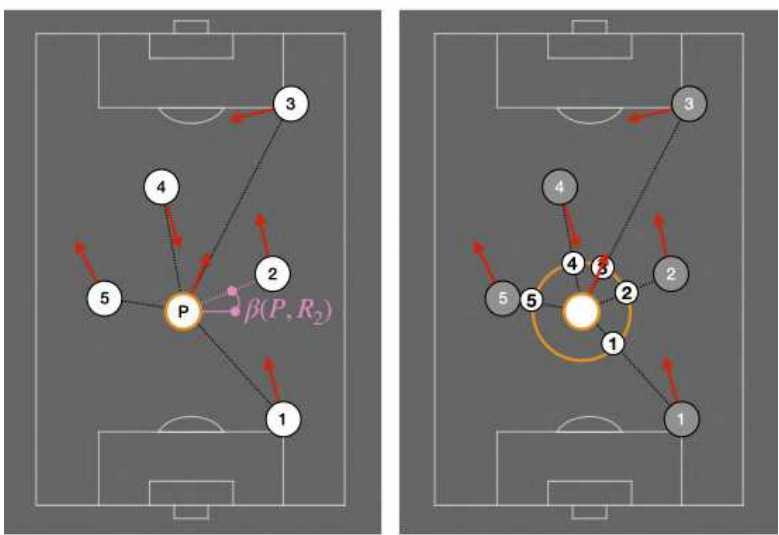
In this model, all potential receivers Ri are placed at an equal distance Z from the passer, maintaining the original angle between the passer and each receiver. An isosceles triangle TP is defined based on the passer’s orientation, representing the field of view in which the passer can make the pass. Similarly, for each receiver Ri, a triangle TRi is defined, indicating the receiver’s field of view from which they can receive a pass. The orientation-based feasibility score is computed as the weighted area of the intersection between triangles TP and TRi.
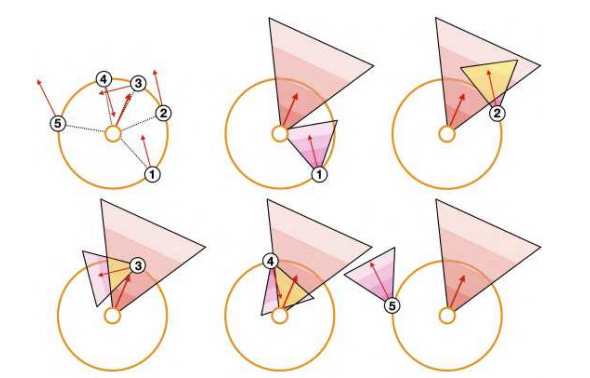
The weights in the feasibility score formula account for the relative position of points within the computed triangles, fading out in further positions to avoid overestimating the intersection. Additionally, different triangle heights are used to prevent players located behind a passer from having significant intersections, even when the passer is not looking backward.
Defenders Position
In this section of the research paper focuses on the impact of defenders’ positions on the decision-making process for passing events in football. The behavior of defenders plays a crucial role in determining the feasibility of a pass, even if a player is well-positioned and oriented. The authors propose a computational model to assess the feasibility of passes based on the location of defenders in relation to the passer and potential receiver.
The model considers two main feasibility scores related to defenders: Fd,P(Ri) and Fd,R(Ri). Fd,P(Ri) represents the feasibility of passing in the direction of the angle β(P, Ri), which is the angle between the passer P and the receiver Ri. This score is calculated based on the Euclidean distances of the J nearest neighbor defenders from the passer, where J is a predefined parameter. The distance weights are defined to emphasize defenders close to the passing line, indicating a higher risk for that specific pass. This process is illustrated in Figure 3, where the three closest defenders are highlighted for two hypothetical passes.

Similarly, Fd,R(Ri) represents the feasibility of receiving the ball from the passer for the receiver Ri. To have two independent quantities, the J nearest neighbors considered when computing Fd,P(Ri) are discarded, and the closest weighted defenders are found with respect to the receiver. The final defenders’ feasibility score, Fd(Ri), is then defined as the product of Fd,P(Ri) and Fd,R(Ri), representing the likelihood of a pass event to a particular player given the defensive spatial configuration.
Overall, the proposed defenders-based feasibility model adds an essential component to the pass decision-making process by taking into account the positioning and proximity of defenders to both the passer and the receiver. This comprehensive analysis contributes to a more accurate assessment of pass success in dynamic football scenarios.
Pairwise Distances
The following part of the paper focuses on the impact of pairwise distances between players on the feasibility of passing options. The position of players in the 2D field significantly affects their chances of receiving the ball, with players located closer to the passer having a higher probability of being chosen as potential receivers.
To quantify this proximity-based feasibility, the authors propose a measure denoted as Fp(Ri). The feasibility score Fp(Ri) is inversely proportional to the Euclidean distance between the passer P and the potential receiver Ri. The authors use an exponential function to calculate the feasibility score, where the distance d(P, Ri) is the distance between the passer and the receiver in the 2D field.
The idea behind this proximity-based feasibility measure is to emphasize players who are physically closer to the passer, making them more likely to be chosen as potential candidates for receiving the ball during a passing event. This measure complements the orientation and defenders-based feasibility measures introduced in previous sections, providing a comprehensive analysis of the factors that influence the most plausible passing options on the field. The inclusion of pairwise distances in the computational model further enhances the accuracy of pass decision-making in dynamic football situations.
Combination
In the end, the research paper introduces a method to combine the three independent feasibility measures derived from the orientation, defenders’ position, and pairwise distances, respectively. The goal is to obtain a comprehensive and robust measure that accurately evaluates the feasibility of potential passes in football.
The proposed method combines the three feasibility scores using Equation (2). The researchers emphasize that even if the other two feasibility values are high, a low feasibility value in any one of the three features (orientation, defenders, or distance) indicates a highly risky pass. In other words, the feasibility of a pass is determined by its weakest aspect, ensuring that the overall feasibility score reflects the most limiting factor in the passing situation.
By combining the three feasibility measures, the model can holistically evaluate passing options, taking into account various factors such as players’ orientation, defenders’ positions, and pairwise distances. This integration leads to a more sophisticated and accurate assessment of passing possibilities on the football field, enabling coaches and analysts to make well-informed decisions about the most viable passing strategies for optimal team performance.
Results
The authors then present the experimental findings and analysis of the proposed pass-orientation model’s performance. The dataset used for the experiments includes 11 full games of F.C. Barcelona, comprising 6038 pass events, each tagged with a binary flag indicating the success or failure of the pass. The main objective is to investigate the correlation between proper player orientation and successful receptions, aiming to enhance the probability of creating goal opportunities.
To evaluate the impact of including player orientation, the paper introduces a baseline pass model (Fpd) that only utilizes the output of Fp (proximity) and Fd (defenders’ position) feasibility measures. The primary metric used for accuracy assessment is the Top-X metric, which measures the percentage of times the ground truth receiver (actual recipient of the pass) is included in the top X candidates predicted by the feasibility models. The paper examines Top-1 and Top-3 accuracy metrics under different conditions, and histograms are plotted to visualize the distribution of candidate receivers’ rankings according to the feasibility values.
The histograms provide insights into the model’s performance by comparing successful (blue) and unsuccessful (orange) pass events. Each bin in the histogram represents the number of times the ground truth receiver is considered as the nth best candidate receiver, with n ranging from 1 to 10 (excluding the goalkeeper). The height of each bin indicates how often the actual receiver is ranked at a specific position in the list of candidates suggested by the feasibility scores.
Orientation Relevance in Pass Feasibility
The researchers also evaluate the significance of player orientation in the proposed pass feasibility model (F) by comparing it to a baseline feasibility model (Fpd) that excludes orientation. The results show that including orientation in the feasibility computation plays a crucial role in determining the outcome of passes.
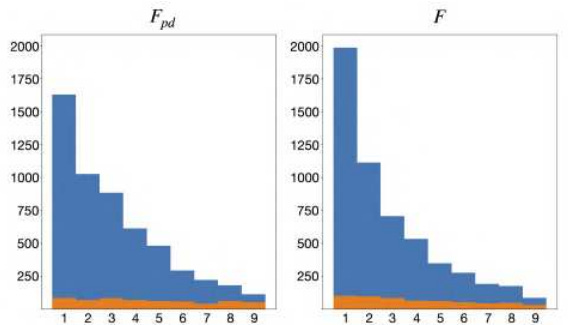
Table 1 presents the Top-1 and Top-3 accuracy metrics for both F and Fpd. The metrics clearly demonstrate that the features introduced in the feasibility computation are highly correlated with the success of the passes. The difference in accuracy between successful and unsuccessful passes is significantly higher when orientation is included, indicating that player orientation is a critical factor in passing success. F outperforms Fpd in both Top-1 and Top-3 accuracy metrics by a margin of 0.07 and 0.05, respectively, emphasizing the importance of orientation in pass feasibility.

The paper further analyzes the individual performance of the three independent feasibility measures: Fp (proximity), Fd (defenders’ position), and Fo (orientation). Table 2 and Figure 5 present the results, and they reveal interesting insights. For successful passes, the histograms of all three components have similar shapes, indicating their collective importance. Fp places higher values in the top bins, suggesting that passing to players far away from the ball is unlikely. On the other hand, Fd and Fp components are more relevant for unsuccessful passes, with Fd being particularly significant. This implies that passing to a well-defended player is more likely to result in a turnover. Fo resembles Fp in shape but is more evenly distributed.
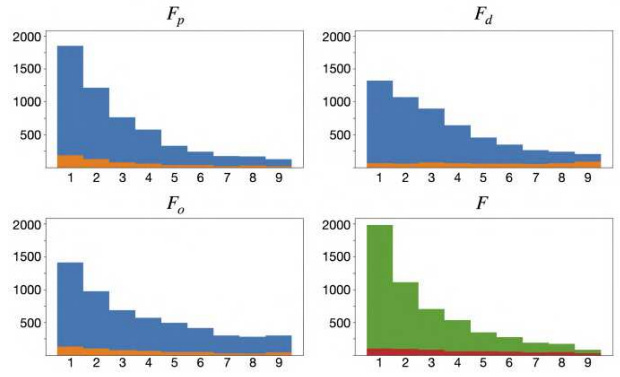
The paper highlights the significance of combining all three feasibility measures (F) to provide comprehensive contextualization. Combining them preserves the high Top-1 and Top-3 accuracy metrics of Fp, while retaining the impact of Fd on distinguishing successful and unsuccessful passes. The research successfully achieves the goal of creating a feasibility measure (F) that comprehensively incorporates player orientation, distance, and defenders’ position, leading to improved pass prediction and decision-making in football gameplay. The results of the analysis validate the effectiveness of the proposed pass-orientation model in enhancing team performance and strategic planning during matches.

Players’ Field Position / Game Phase
In this section the research paper investigates the impact of orientation as a feasibility measure on different player positions and game phases in football. Players are classified into defenders, midfielders, and forwards, and the feasibility measure is applied to evaluate their pass success rates. Additionally, the effect of orientation is examined based on the location of the passer relative to the defensive team’s spatial configuration, leading to the identification of three offensive play phases: build-up, progression, and finalization.
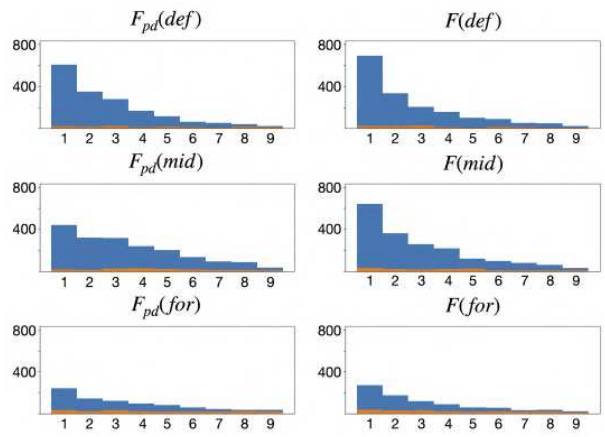
The results presented in Figure 6 and Table 3 indicate that midfielders are the players most influenced by orientation in the feasibility measure. When orientation is incorporated, both Top-1 and Top-3 accuracy metrics improve by 0.10, while maintaining a similar difference in success rates between successful and unsuccessful passes for midfielders. Defenders, on the other hand, are less impacted by orientation, as they often perform secure passes within their defensive zone, where orientation plays a lesser role. Forwards are also influenced by orientation, but they have fewer pass interactions and experience higher turnover risk and potential rewards in their domain.
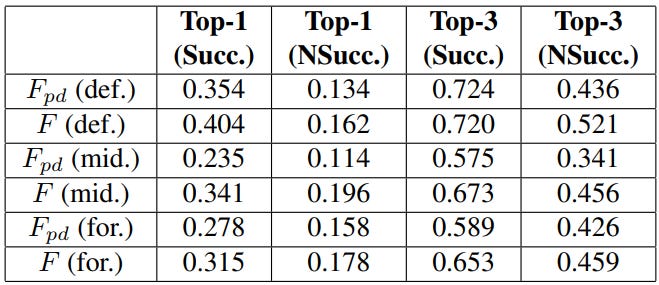
The study further investigates the game phases based on the location of the passer relative to the defensive team’s arrangement. Three phases are identified: build-up, progression, and finalization, represented in Figure 7.
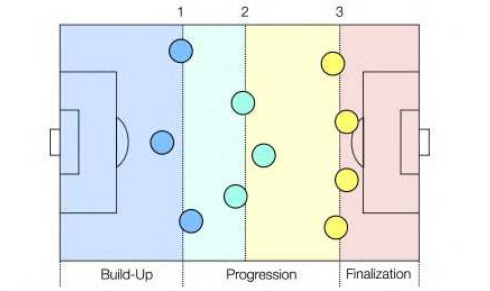
The analysis shows that the effect of orientation is particularly significant in the progression phase, with a substantial difference in both Top-1 and Top-3 accuracy metrics, exceeding 0.2. In the build-up and finalization phases, which represent lower and higher risk situations, respectively, the inclusion of orientation also enhances the pass accuracy metrics.

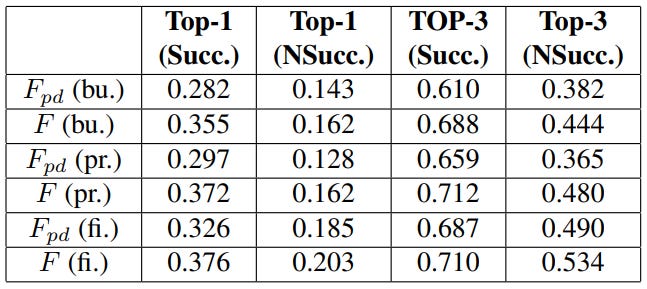
Overall, the research demonstrates the importance of player orientation in determining pass feasibility in different player positions and game phases. By incorporating orientation as a key feature in the proposed pass feasibility model, the study provides valuable insights into optimizing passing decisions, enhancing team performance, and strategically planning offensive plays in football.
Combination with Expected Possession Value
Next, the authors explore the integration of player orientation into the existing EPV model, which aims to assign value to individual actions in football, particularly focusing on pass probability modeling. The current EPV model lacks consideration of players’ body orientation, leading to somewhat accurate yet improvable results. An example in Figure 9 illustrates the limitation, where the EPV model fails to penalize a risky pass due to the passer’s restricted field of view, resulting in potential inefficiencies.
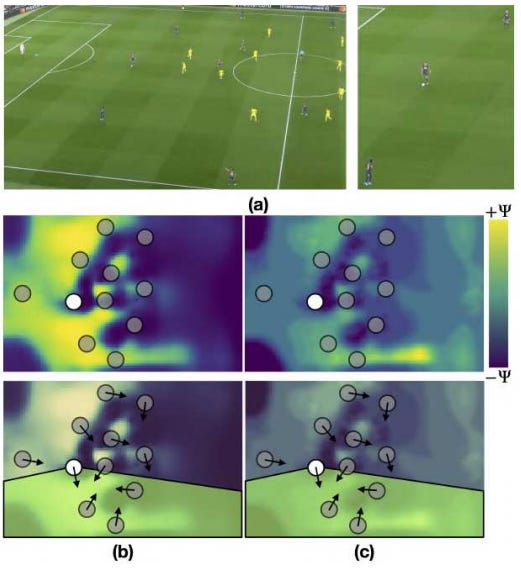
To address this limitation, the paper proposes combining the orientation-based feasibility measure Fo with the output maps of the original pass probability model (VP) or the EPV model (VE). However, a challenge arises due to the dimension misalignment between the output maps (discretized field positions) and the individual feasibility values for potential receivers (10 candidates). To resolve this, a geometrical approach is employed, integrating the probability/EPV values over meaningful areas extending from the passer to each receiver candidate.

The final individual value for receiver Ri, denoted as V(Ri), is obtained by integrating the probability/EPV values over a disc Qi of radius q and a tubular region Si of fixed width s, both centered at the 2D field position of the receiver. The regions Qi and Si allow for capturing the significance of the pass along its trajectory. The approach can be used for both types of maps (VP or VE), enhancing the individual probabilities/expected values by considering player orientation Fo.
The results presented in Table 5 and Figure 11 demonstrate that incorporating orientation significantly improves the accuracy in all scenarios, especially in the top-1 accuracy case, achieving a boost of nearly 0.1 for the pass probability model. Orientation also enhances the raw performance of the EPV model, enhancing the accuracy by 0.07 in top-1 accuracy, particularly for cases where players are located outside the passer’s field of view.
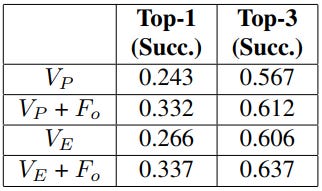
The research concludes that integrating orientation into the state-of-the-art implementation of EPV could lead to a more accurate model, offering better insights into the decision-making process and optimizing individual/team performance in football. The combination of orientation-based feasibility with EPV’s pass probability modeling demonstrates the potential for refining existing models to provide more nuanced and context-aware pass analysis and strategic decision-making on the field.
Conclusions
In this research paper, the authors have presented a novel computational model designed to estimate the feasibility of passes in football games. The primary contribution of this model is the incorporation of orientation data, which is directly extracted from video frames using pose-models. The inclusion of orientation data is found to be crucial in the decision-making process of players and is strongly correlated with the outcome of plays.
The orientation feasibility is computed using a geometrical approach that considers the offensive players’ positions and orientations on the field. This information is then combined with two other estimations: one based on the location of defenders concerning potential receivers and the other based on pairwise distances between players.
Furthermore, the researchers have studied the combination of their model’s output with existing pass probability and Expected Possession Value (EPV) models. The results show promising outcomes, indicating that state-of-the-art methods can be enhanced by incorporating orientation data.
As part of future work, the authors plan to explore the viability of this model in other sports, potentially extending the passing feasibility discretization to the entire field. Additionally, they propose using orientation as a core feature for team action recognition, which could optimize team tactical strategies based on the spatial offensive configuration. This research opens up exciting possibilities for improving decision-making and strategic planning in football and potentially other team sports through the integration of player orientation data.
References
Arbues-Sanguesa, A., Martín, A., Fernández, J., Ballester, C., & Haro, G. (2020). Using player’s body-orientation to model pass feasibility in soccer. In Proceedings of the IEEE/CVF Conference on Computer Vision and Pattern Recognition Workshops (pp. 886–887). https://openaccess.thecvf.com/content_CVPRW_2020/papers/w53/Arbues-Sanguesa_Using_Players_Body-Orientation_to_Model_Pass_Feasibility_in_Soccer_CVPRW_2020_paper.pdf







